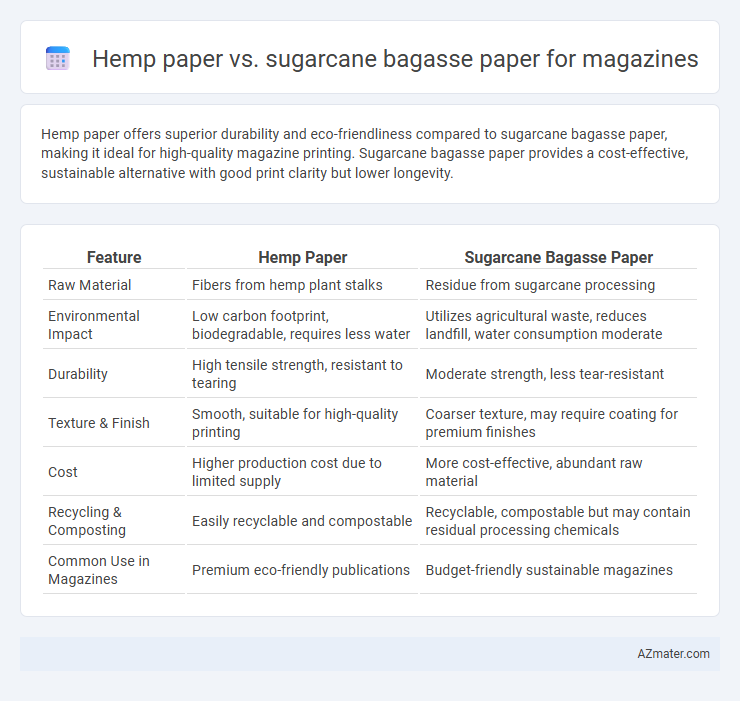Hemp paper offers superior durability and eco-friendliness compared to sugarcane bagasse paper, making it ideal for high-quality magazine printing. Sugarcane bagasse paper provides a cost-effective, sustainable alternative with good print clarity but lower longevity.
Table of Comparison
| Feature | Hemp Paper | Sugarcane Bagasse Paper |
|---|---|---|
| Raw Material | Fibers from hemp plant stalks | Residue from sugarcane processing |
| Environmental Impact | Low carbon footprint, biodegradable, requires less water | Utilizes agricultural waste, reduces landfill, water consumption moderate |
| Durability | High tensile strength, resistant to tearing | Moderate strength, less tear-resistant |
| Texture & Finish | Smooth, suitable for high-quality printing | Coarser texture, may require coating for premium finishes |
| Cost | Higher production cost due to limited supply | More cost-effective, abundant raw material |
| Recycling & Composting | Easily recyclable and compostable | Recyclable, compostable but may contain residual processing chemicals |
| Common Use in Magazines | Premium eco-friendly publications | Budget-friendly sustainable magazines |
Introduction to Sustainable Magazine Papers
Hemp paper offers exceptional durability and biodegradability, making it an ideal choice for sustainable magazine production due to its rapid growth cycle and low environmental impact. Sugarcane bagasse paper, derived from the fibrous residue left after juice extraction, provides a renewable alternative that reduces agricultural waste and conserves forests. Both materials contribute to eco-friendly publishing by minimizing carbon footprints and supporting circular economy principles in magazine printing.
Overview of Hemp Paper Production
Hemp paper production involves harvesting the hemp stalks, which contain long, strong fibers ideal for creating durable and sustainable paper products. The fibers undergo processes such as retting, decortication, and pulping to produce a high-quality pulp with minimal chemical use, resulting in environmentally friendly paper. Compared to sugarcane bagasse paper, hemp paper offers superior strength, longevity, and a lower environmental footprint due to hemp's fast growth and minimal resource requirements.
Overview of Sugarcane Bagasse Paper Production
Sugarcane bagasse paper production utilizes the fibrous residue left after extracting juice from sugarcane, providing an eco-friendly alternative to traditional wood pulp and hemp paper. This process involves pulping the bagasse fibers through mechanical and chemical treatments, followed by bleaching and drying to create a durable, recyclable paper often used in magazines. Compared to hemp paper, sugarcane bagasse paper offers a cost-effective solution while reducing deforestation and promoting sustainable agricultural waste management.
Environmental Impact Comparison
Hemp paper offers superior environmental benefits due to its rapid growth rate, requiring fewer pesticides and less water compared to traditional crops, while producing stronger fibers that increase durability and reduce waste. Sugarcane bagasse paper utilizes the fibrous residue from sugar production, effectively recycling agricultural byproducts and minimizing deforestation, yet its chemical processing can generate pollutants if not managed properly. Both materials contribute to sustainable paper production, but hemp's lower resource input and biodegradability make it a more eco-friendly choice for magazine printing.
Fiber Quality and Print Performance
Hemp paper offers superior fiber quality due to its long, strong bast fibers, resulting in enhanced durability and a smooth surface ideal for high-resolution magazine printing. Sugarcane bagasse paper, derived from short, brittle fibers, often exhibits lower tear resistance and a rougher texture, which can affect print clarity and color vibrancy. The durability and print performance of hemp paper make it a preferred choice for premium magazines requiring crisp images and long-lasting pages.
Cost and Economic Viability
Hemp paper generally incurs higher production costs due to intensive cultivation and processing compared to sugarcane bagasse paper, which leverages abundant agricultural waste, reducing raw material expenses. Sugarcane bagasse paper offers greater economic viability for magazine printing by utilizing a low-cost, renewable resource that supports scalable manufacturing and lowers overall expenditure. While hemp paper boasts superior durability and eco-friendliness, sugarcane bagasse paper provides a cost-effective balance suited for high-volume magazine production.
Availability and Supply Chain Considerations
Hemp paper benefits from a relatively limited but steadily growing supply chain due to the controlled cultivation of hemp plants, which can impact availability and lead times, especially in regions with strict regulations. Sugarcane bagasse paper leverages the abundant byproduct of sugar production, offering a more consistent and scalable supply chain with lower raw material costs. For magazines, choosing sugarcane bagasse paper often ensures better availability and a more reliable supply chain compared to hemp paper, which may face intermittent supply limitations.
Biodegradability and Recycling Potential
Hemp paper exhibits superior biodegradability compared to sugarcane bagasse paper, decomposing more rapidly due to its natural fiber composition and minimal chemical processing. Both materials maintain strong recycling potential, yet hemp paper often produces higher-quality recycled fiber suitable for multiple reuse cycles, enhancing sustainability in magazine production. Sugarcane bagasse paper, while biodegradable, may contain additives affecting its compostability and recycling efficiency in industrial processes.
Regulatory and Certification Standards
Hemp paper and sugarcane bagasse paper both meet essential regulatory and certification standards such as FSC (Forest Stewardship Council) and PEFC (Programme for the Endorsement of Forest Certification), ensuring sustainable sourcing and eco-friendly production. Hemp paper benefits from stricter global agricultural regulations limiting pesticide use, promoting organic farming practices that enhance certification credibility. Sugarcane bagasse paper aligns with ISO 14001 environmental management standards, supporting waste reduction and energy efficiency in manufacturing processes favored by magazine publishers seeking green certifications.
Conclusion: Best Choice for Eco-Friendly Magazines
Hemp paper offers superior durability, higher fiber strength, and requires less water and pesticides in cultivation compared to sugarcane bagasse paper, making it a more sustainable option for eco-friendly magazines. Sugarcane bagasse paper is a valuable byproduct use that reduces agricultural waste but generally has lower durability and brightness. For publishers prioritizing longevity, environmental impact, and print quality, hemp paper emerges as the best choice for eco-friendly magazines.

Infographic: Hemp paper vs Sugarcane bagasse paper for Magazine
 azmater.com
azmater.com